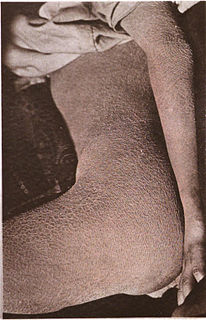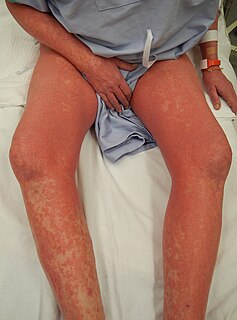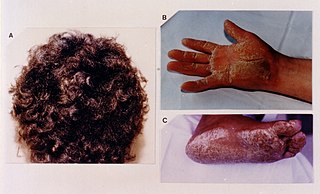Related Research Articles

Ichthyosis is a family of genetic skin disorders characterized by dry, thickened, scaly skin. The more than 20 types of ichthyosis range in severity of symptoms, outward appearance, underlying genetic cause and mode of inheritance. Ichthyosis comes from the Greek ἰχθύς ichthys, literally "fish", since dry, scaly skin is the defining feature of all forms of ichthyosis.

Lamellar ichthyosis, also known as ichthyosis lamellaris and nonbullous congenital ichthyosis, is a rare inherited skin disorder, affecting around 1 in 600,000 people.

Palmoplantar keratodermas are a heterogeneous group of disorders characterized by abnormal thickening of the stratum corneum of the palms and soles.

X-linked ichthyosis is a skin condition caused by the hereditary deficiency of the steroid sulfatase (STS) enzyme that affects 1 in 2000 to 1 in 6000 males. XLI manifests with dry, scaly skin and is due to deletions or mutations in the STS gene. XLI can also occur in the context of larger deletions causing contiguous gene syndromes. Treatment is largely aimed at alleviating the skin symptoms. The term is from the Ancient Greek 'ichthys' meaning 'fish'.

Sézary disease, or Sézary syndrome is a type of cutaneous T-cell lymphoma that was first described by Albert Sézary. The affected T-cells known as Sézary's cells, and also as Lutzner cells, have pathological quantities of mucopolysaccharides. Sézary disease is sometimes considered a late stage of mycosis fungoides with lymphadenopathy.
Conradi–Hünermann syndrome is a rare type of chondrodysplasia punctata. It is associated with the EBP gene and affects between one in 100,000 and one in 200,000 babies.

Genodermatosis is a hereditary skin disease with three inherited modes including single gene inheritance, multiple gene inheritance and chromosome inheritance. There are many different types of genodermatosis, the prevalence of genodermatosis ranges from 1 per 6000 people to 1 per 500,000 people. Genodermatosis has influence on the texture, color and structure of skin cuticle and connective tissue, specific lesion site and clinical manifestations on the body vary depending on the type. In the spite of the variety and complexity of genodermatosis, there are still some common methods that can help people diagnose. After diagnosis, different types of genodermatosis require different levels of therapy including interventions, nursing interventions and treatments. Among that, research of therapy for some new, complex and rare types are still in the developing stage. The impact of genodermatosis not only can be seen in body but also can be seen in all aspects of patients’ life, including but not limited to psychological, family life, economic conditions and social activities. Accordingly, the patients need treatment, support and help in these areas.

Proteasome maturation protein is a protein that in humans is encoded by the POMP gene. It is a short-lived maturation factor required for 20S proteasome subunit biogenesis.
Congenital ichthyosiform erythroderma (CIE), also known as Nonbullous congenital ichthyosiform erythroderma is a rare type of the ichthyosis family of skin diseases which occurs in 1 in 200,000 to 300,000 births. CIE comes under the umbrella term autosomal recessive congenital ichthyosis (ARCI), which include non-syndromic congenital ichthyoses such as harlequin ichthyosis and lamellar ichthyosis.
Ichthyosis hystrix is a group of rare skin disorders in the ichthyosis family of skin disorders characterized by massive hyperkeratosis with an appearance like spiny scales. This term is also used to refer to a type of epidermal nevi with extensive bilateral distribution.

Camisa disease is the variant form of Vohwinkel syndrome, characterized by ichthyosis and normal hearing.

Naxos disease is a cutaneous condition characterized by a palmoplantar keratoderma. The prevalence of the syndrome is up to 1 in every 1000 people in the Greek islands.
Howel–Evans syndrome is an extremely rare condition involving thickening of the skin in the palms of the hands and the soles of the feet (hyperkeratosis). This familial disease is associated with a high lifetime risk of esophageal cancer. For this reason, it is sometimes known as tylosis with oesophageal cancer (TOC).
Ichthyosis prematurity syndrome (IPS) is a dermatological disease with known genetic causes. This syndrome is a rare subcategory of autosomal recessive congenital ichthyosis (ARCI). It is associated with complications in the mid-trimester of a pregnancy leading to premature births. Although most prevalent in individuals of Scandinavian origin, there have also been scattered cases in people of Japanese, Italian and Indian ethnicity. This disorder is also referred to as ichthyosis congenital type IV.
Bart–Pumphrey syndrome is a cutaneous condition characterized by hyperkeratoses over the metacarpophalangeal, proximal and distal interphalangeal joints.
Cerebral dysgenesis–neuropathy–ichthyosis–keratoderma syndrome is a neurocutaneous condition caused by mutation in the SNAP29 gene.
Neonatal ichthyosis–sclerosing cholangitis syndrome is a cutaneous condition caused by mutations in the Claudin 1 gene.
Haim–Munk syndrome is a cutaneous condition caused, like Papillon-Lefevre Syndrome, by a mutation in the cathepsin C gene. It is named after Dr. Salim Haim and Dr. J Munk, who first described the disease in 1965.
Laryngo-onycho-cutaneous syndrome is a rare epithelial disorder inherited in an autosomal recessive fashion. It is characterized by abnormalities in the larynx, nails, and skin ("cutaneous"). The disorder is only found in Punjabi Muslims and only a few cases have been reported.
References
- ↑ Rapini, Ronald P.; Bolognia, Jean L.; Jorizzo, Joseph L. (2007). Dermatology: 2-Volume Set. St. Louis: Mosby. p. 778. ISBN 978-1-4160-2999-1.
- ↑ Pujol RM, Moreno A, Alomar A, de Moragas JM (January 1989). "Congenital ichthyosiform dermatosis with linear keratotic flexural papules and sclerosing palmoplantar keratoderma". Arch Dermatol. 125 (1): 103–6. doi:10.1001/archderm.125.1.103. PMID 2521286. Archived from the original on 2012-03-08.
- ↑ Dahlqvist J, Klar J, Tiwari N, et al. (April 2010). "A single-nucleotide deletion in the POMP 5' UTR causes a transcriptional switch and altered epidermal proteasome distribution in KLICK genodermatosis". Am. J. Hum. Genet. 86 (4): 596–603. doi:10.1016/j.ajhg.2010.02.018. PMC 2850438 . PMID 20226437.
- ↑ Baeta, IG; Pereira, AC; Guedes, AC; Pereira, LB (2011). "Do you know this syndrome?". Anais Brasileiros de Dermatologia. 86 (3): 605–7. doi: 10.1590/S0365-05962011000300036 . PMID 21738991.

- 1 2 Foley, Catherine C.; Paller, Amy S.; Irvine, Alan D. (2015). "Chapter 19: Disorders of cornification (icthyosis)". In Eichenfield, Lawrence F.; Frieden, Ilona J. (eds.). Neonatal and infant dermatology (3rd ed.). Elsevier Inc. p. 301. ISBN 978-1-4557-2638-7.